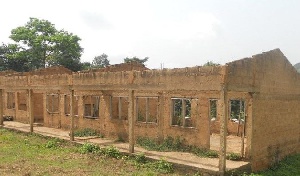About 18.6percent of MMDAs investment expenditure is deteriorating, as some public projects are unlikely to ever get completed.
This is according to a study conducted by the World Bank, on the Spatial Infrastructure Data in Ghana.
The cost of abandoned projects is estimated at US$25 million annually [GH¢120.29 million currently]. This is equivalent to 667 additional three unit classroom blocks annually, which could have served an estimated 70,000students.
From an original database of over 14,000 small development projects in the various MMDAs from2011 to 2013, it is estimated that one-third of projects that start are never get completed, consuming one-fifth of all local government investments.
All these projects had funding from different funding sources such the District Assemblies Common Fund (DACF), Donor funds, internally generated fund (IGF),GETFund, or Central Government funding.
Presenting the findings from the study, Associate Professor in Public Management at the Blavatnik School of Government, University of Oxford, Dr. Martin J. Williams said, “in the first year, about 45 percent of projects get completed, but after three years only 60 to 65 percent get completed, beyond that it is extremely likely they are not going to be completed.”
According to the Auditor General’s report on the utilization of the District Assemblies’ Common Fund, abandoned and unused projects in at least 40Metropolitan, Municipal and District Assemblies (MMDAs) cost the state over GH¢30 million in 2017.
This figure contributed to 73 percent of the losses from irregularities. The losses and abandoned projects contributed to what the Auditor General classified as contract irregularities.
Whilst other major irregularities saw a drop in 2017 from 2016, the contract irregularities increased from GH¢ 26,839,675.97 to GH¢ 31,224,856.72.
Explaining the cause of the in completion of projects, Dr. Williams indicated that,districts are taking on projects beyond their capacity of funding and their budgeted investment funds.
From the study, school projects remained the least completed as scheduled.
Dr. Williams said, “What is happening is that districts start five budgeted projects, and then other communities begin to complaining of not getting projects. So the funds available to complete the original five projects will then be used to start an additional five projects, with the view of completing the projects in the next year.
“But the next year, there will be other communities also wanting projects, hence, the districts end up using the funds allocated to complete the previous projects on a new set of projects,” He added.
Infrastructure Database
Although the country spends huge sums on building infrastructure, yet, there is no data to effectively plan and manage these investments.
In this context, Dr. Williams indicated that a comprehensive National Infrastructure Database (NID) covering all public infrastructure would be an invaluable resource.
Business News of Wednesday, 12 December 2018
Source: goldstreetbusiness.com
MMDAs abandoned projects cost US$25m annually
Entertainment












